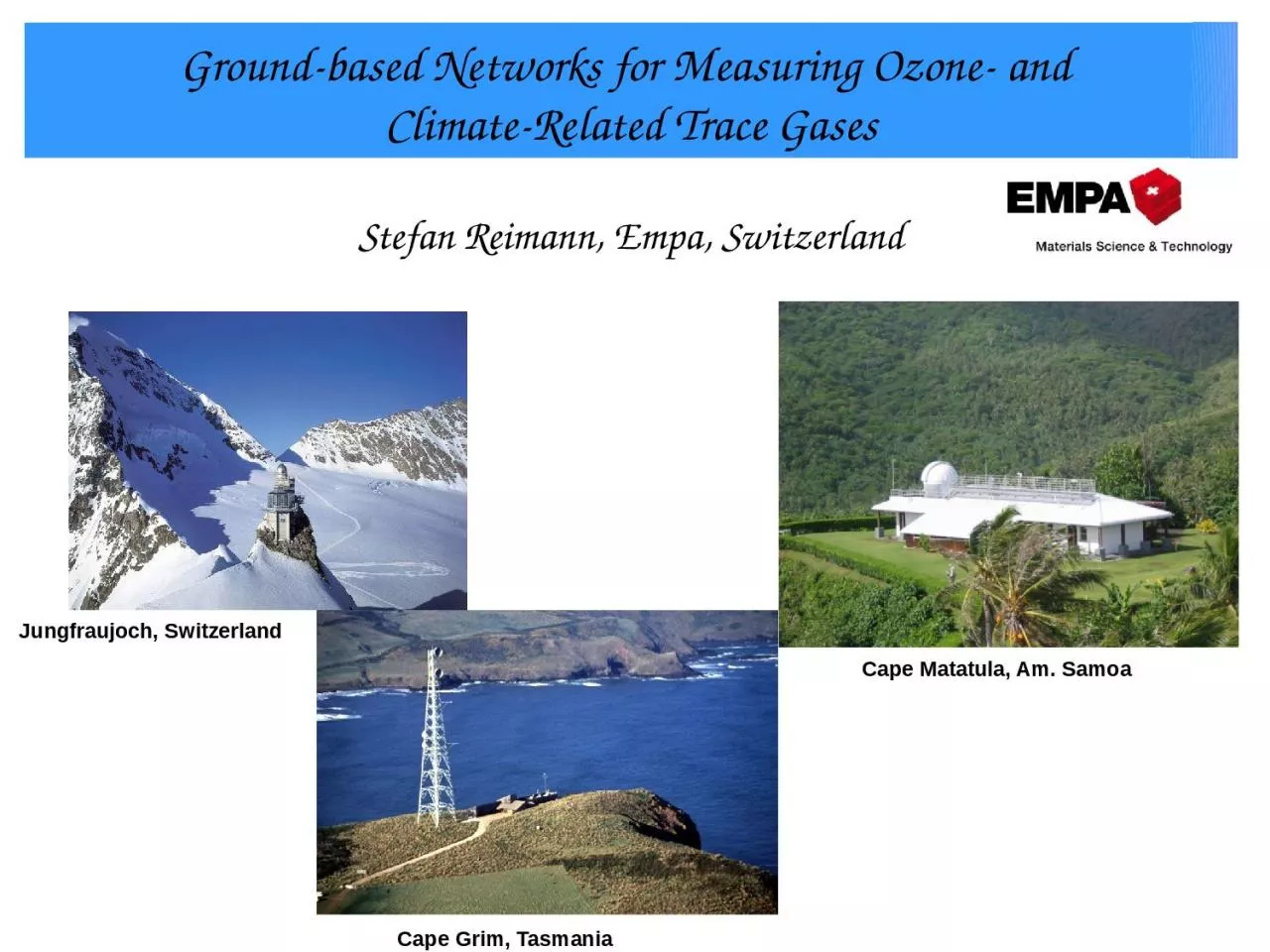

Groundbased Networks for Measuring Ozone and ClimateRelated Trace Gases Cape Matatula Am Samoa Cape Grim Tasmania Jungfraujoch Switzerland Groundbased Continuous Networks Column measurements NDACC ID: 934536
Download Presentation The PPT/PDF document "Stefan Reimann, Empa, Switzerland" is the property of its rightful owner. Permission is granted to download and print the materials on this web site for personal, non-commercial use only, and to display it on your personal computer provided you do not modify the materials and that you retain all copyright notices contained in the materials. By downloading content from our website, you accept the terms of this agreement.
Slide1
Stefan Reimann, Empa,
Switzerland
Ground-based Networks for Measuring Ozone- and
Climate-Related Trace Gases
Cape Matatula, Am. Samoa
Cape
Grim
, Tasmania
Jungfraujoch, Switzerland
Slide2Ground-based
Continuous
Networks
Column measurements: NDACC
In-situ measurements: NOAA (ESRL)/AGAGE
Results from Ground-based Continuous NetworksCFCs/chlorinated solvents: abundance and emissionsCCl
4: sources and sinks: an update
“new” CFCsHCFCs/HFCs
: abundance and emissions
climate impact of CFCs/HCFCs/HFCs and new replacement compounds
Overview
Slide3Ground-based
Continuous
Networks
Column measurements: NDACC
In-situ measurements: NOAA (ESRL)/AGAGE
Results from Ground-based Continuous NetworksCFCs/chlorinated solvents: abundance and emissions
CCl4
: sources and sinks: an update“new” CFCs
HCFCs/HFCs: abundance and emissions
climate impact of CFCs/HCFCs/HFCs and new replacement compounds
Overview
Slide4Network for the Detection of
Atmospheric Composition Change (NDACC
)
FTIR network
Slide5Results of NDACC
Provided by E. Mahieu,
University of Liège
Slide6in-situ Measurements
NOAA
(ESRL)/AGAGE
NOAA/ESRL
Halocarbon Surface and Aircraft Sampling Network
AGAGE
Continuous Halocarbon in-situ Sampling Network
Slide7Results of ground-based
in-situ networks for CFCs and chlorinated solvents
Global emission:
12-box model
Concentrations
Slide8Results of ground-based
in-situ networks for CFCs and chlorinated solvents
Emissions
Slide9Ground-based
Continuous
Networks
Column measurements: NDACC
In-situ measurements: NOAA (ESRL)/AGAGE
Results from Ground-based Continuous NetworksCFCs/chlorinated solvents: abundance and emissionsCCl
4: sources and sinks: an update
“new” CFCsHCFCs/HFCs
: abundance and emissions
climate impact of CFCs/HCFCs/HFCs and new replacement compounds
Overview
Slide10NOAA
AGAGE
Emissions with Lifetime = 26 yr
Results of ground-based
in-situ
networks for Carbon Tetrachloride (CCl4) issue
Emissions derived from measurements
Slide11Potential Emissions
=
Production – Feedstock
Emissions derived from UNEP reportingResults of ground-based in-situ
networks for Carbon Tetrachloride (CCl4) issue
Slide12Possible reasons for the discrepancy:
Emissions from production/feedstock/destruction?Emissions from old industrial sites/landfills?
Estimated atmospheric lifetime (26 yr) too small?
UNEP emissions
1600 railway freight cars
emitted per year
Emissions (T=26 yr)
Results of ground-based
in-situ
networks for
Carbon Tetrachloride
(
CCl
4
) issue
Slide13Ground-based
Continuous
Networks
Column measurements: NDACC
In-situ measurements: NOAA (ESRL)/AGAGE
Results from Ground-based Continuous NetworksCFCs/chlorinated solvents: abundance and emissionsCCl
4: sources and sinks: an update
“new” CFCs
HCFCs/HFCs: abundance and emissions
climate impact of CFCs/HCFCs/HFCs and new replacement compounds
Overview
Slide14Laube
et al
.,
Nature Geoscience, 2014
Results of ground-based in-situ
networks “New” ozone-depleting susbtances
chlorofluorocarbon: CFC-112
Slide15Laube
et al., Nature Geoscience, 2014
Results of ground-based
in-situ networks “New” ozone-depleting susbtances
chlorofluorocarbon: CFC-113a
Concentrations: very low, partly increasing
Emissions: low, partly increasing
“
New” ODSs
:
Slide16Ground-based
Continuous
Networks
Column measurements: NDACC
In-situ measurements: NOAA (ESRL)/AGAGE
Results from Ground-based Continuous NetworksCFCs/chlorinated solvents: abundance and emissionsCCl
4: sources and sinks: an update
“new” CFCsHCFCs/HFCs
: abundance and emissions
climate impact of CFCs/HCFCs/HFCs and new replacement compounds
Overview
Slide17Results of ground-based
in-situ networks for ozone-depleting substances
Concentrations
Emissions
Concentrations: still increasing
Emissions: total ~stable
HFCF-141b reincreasing?
HCFCs:
Slide18Results of ground-based
in-situ networks Hydrofluorocarbons (HFCs)
Concentrations
EmissionsConcentrations: increasingEmissions: increasing
HFCs:
Slide19Ground-based
Continuous
Networks
Column measurements: NDACC
In-situ measurements: NOAA (ESRL)/AGAGE
Results from Ground-based Continuous NetworksCFCs/chlorinated solvents: abundance and emissionsCCl
4: sources and sinks: an update
“new” CFCsHCFCs/HFCs
: abundance and emissions
climate impact of CFCs/HCFCs/HFCs and new replacement compounds
Overview
Slide20Emissions as CO
2
-Equivalents:
Ozone-depleting substances and HFCs
Slide21Emissions as CO
2
-Equivalents:
Ozone-depleting substances and HFCs
Slide22Proposal
to amend the Montreal Protocol to include
HFCshttp://ozone.unep.org/Meeting_Documents/mop/22mop/MOP-22-5E.pdf
Slide23Long-lived ozone-depleting substances (ODSs) are mainly behaving as expected
CCl4
sources estimated from measurements are higher than reconciled by inventoriesNew ODSs have been detected in the atmosphere, but their influence on stratospheric ozone is still negligibleHFCs as replacement compounds are increasing and CO2 equivalent emissions are similar to CFCs and HCFCs
Continuous measurements of ozone-depleting substances are
needed to check trends and compliance with international Protocols
Conclusions
Slide24Contributions from
:
NOAA(ESRL)AGAGEBradley
Hall (NOAA)Emmanuel Mahieu (Uni. Liège)Johannes Laube (UEA)
Thank you for your attention!